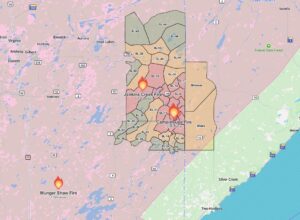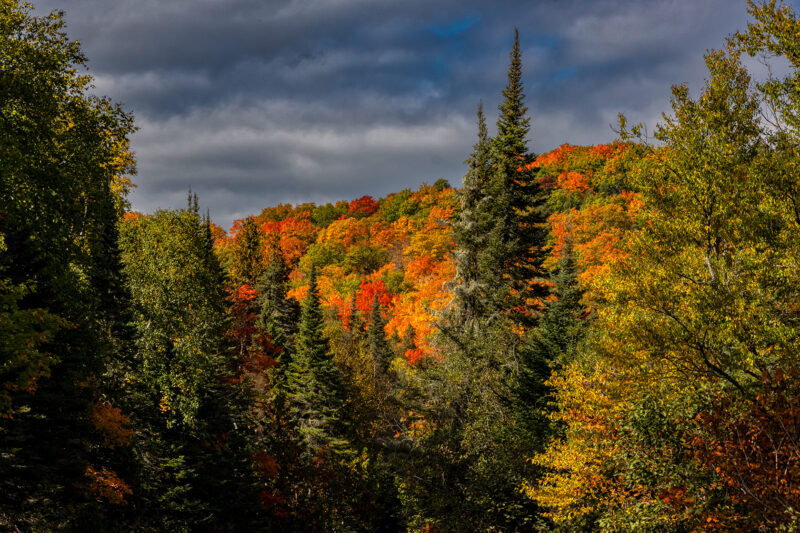Three wildfires burn over 20,000 acres in northern Minnesota, National Guard called to assist
Updated at 11:58 a.m.
Firefighters within multiple agencies are battling three wildfires in St. Louis County, which have burned over 20,000 acres and destroyed 40 structures.
The Camp House fire, near Brimson, ignited on Sunday, May 11, and has burned 12,000 acres. Fire officials said fire behavior has been “extreme” with the fire burning in mixed forest vegetation with large quantities of spruce budworm-infested forest stands. The cause of the fire is under investigation.
The St. Louis County Sheriff’s Office and volunteer St. Louis County Rescue Squad members reported that the fire destroyed an excess of 40 structures late Monday evening.
Gov. Tim Walz authorized the Minnesota National Guard to provide emergency assistance to help fight the Camp House wildfire.
“Wildfires in northern Minnesota have forced families to evacuate and caused severe damage to and loss of property. My thoughts are with those Minnesotans who are being impacted by this dangerous and unpredictable fire,” said Governor Walz. “I’m grateful to the men and women of the Minnesota National Guard for stepping up to this mission, and to all the state and local agencies working tirelessly to contain the fire and protect Minnesotans.”
The Minnesota National Guard will provide personnel, assistance, and resources to support wildfire suppression efforts alongside the Minnesota Department of Natural Resources, the Minnesota Interagency Fire Center, and local agencies.
Evacuation orders are still in effect and have been extended with the northern border now at Greenwood Lake boat access on Hwy 2 and the southern border remaining as the Langley River Rd.
On Tuesday afternoon, the Minnesota Fire Incident Command closed roads along Highway 16 and surrounding area. The public is encouraged to avoid the area.
In a Tuesday report, St. Louis County Sheriff Gordon Ramsey said the fire grew significantly to the north and northwest Monday evening. Dangerous fire conditions continue into Tuesday, with fire officials closely watching the Bassett and Cadotte Lake area.
In-state and out-of-state resources will continue building fire lines with heavy equipment and tracked equipment, the Minnesota Incident Command System said in a Tuesday update.
The Jenkins Creek fire began on Monday and has burned over 6,800 acres. The fire is located approximately 14 miles southeast of Hoyt Lakes. Rapid northerly fire growth occurred throughout Monday and into the evening, fueled by hot temperatures, high winds, and low humidity levels, fire officials said. Fire officials said the fire has destroyed one structure.
Ramsay said fire officials are predicting the fire to grow on Tuesday, which will impact recreation within the immediate area of the Superior National Forest.
“We will give updates throughout the day as things change,” Ramsey said.
Fire officials said on Tuesday afternoon, critical areas at risk are the community of Skibo, the Skibo Mill and the Canadian National Railroad line. The fire is burning in timber mixed with boreal forest and grass which has been heavily impacted by spruce budworm. The cause of the fire has not been determined and is still under investigation, fire officials said.
The Munger Shaw fire, near Cotton, also began on Monday and has burned 1,300 acres. Evacuation orders were lifted late Monday evening for Cotton Township, and fire officials said they will reevaluate if conditions change.
All three wildfires are at zero percent containment.
Ramsay said numerous burned trees from the three fires have fallen on roadways and driveways, causing issues for access throughout the county.
“So be careful out there,” Ramsey said.
The U.S. Forest Service added additional air support on Tuesday to help battle and suppress the wildfires. Aircraft, including 2 Fire Boss single-engine water scooping planes and 2 CL-415 super scooper planes, and helicopters, are dropping water on the Jenkins Creek and Camp House fires.
One of the aircraft helping to suppress the fire and protect private property is a CH-47 Chinook, which can hold 2,300 gallons of water and is filled by a house in 30 to 45 seconds, according to the sheriff’s office.

CH-47 Chinook, which can hold 2,300 gallons of water and is filled by a house in 30 to 45 seconds | Photo by Sheriff’s Office
A video of pilot Earl Watters flying the CH-47 Chinook and dropping gallons of water on the Jenkins Creek and Camp House fires is below.
Widespread critical fire weather conditions are expected again on Tuesday. Temperatures are expected to reach 70 degrees throughout the Superior National Forest with low relative humidity levels and wind gusts reaching 20 mph, according to the Duluth National Weather Service. Red Flag Warnings remain in effect for most of the state.















